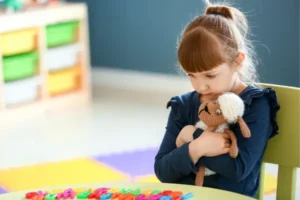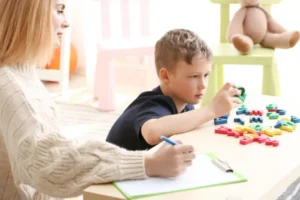Children with autism often face unique challenges in language development, such as delays in speech, difficulties in understanding social cues, and limited verbal or non-verbal communication skills. These challenges can impact their ability to express themselves and connect with others effectively.
Educational toys offer a powerful way to help children with autism overcome these obstacles. These toys engage children in activities that promote language development, foster creativity, and enhance interaction in a fun, supportive environment. In this article, we will explore the top 7 educational toys specifically designed to support speech and language growth in children on the autism spectrum.
Understanding the Role of Speech and Language Educational Toys
Educational toys are essential tools for children with autism because they provide opportunities to practice language skills in an engaging, stress-free way. By incorporating speech and language activities into playtime, these toys help children expand their vocabulary, practice pronunciation, and improve their comprehension of social cues.
Key features of effective language-development toys include:
- Interactivity: Toys that respond with sounds, words, or actions encourage verbal and non-verbal communication.
- Sensory Engagement: Toys that stimulate sight, sound, and touch reinforce language learning by connecting sensory experiences with words and concepts.
- Repetition: Repetitive play helps children practice and internalize speech patterns, making learning more natural and consistent.
By selecting the right toys, parents and caregivers can create a supportive environment that fosters communication growth, allowing children to develop their language skills at their own pace.
Criteria for Selecting the Best Toys for Autism
When choosing educational toys to promote speech and language development for children with autism, several factors should be considered:
- Personalization: Consider toys that can be customized to your child’s interests and learning needs. Engaging your child’s preferences makes the learning process more enjoyable and effective.
- Multisensory Play: Look for toys that engage multiple senses, such as sight, sound, and touch, to reinforce language through different channels.
- Cause-and-Effect Interactions: Toys that respond to actions can encourage communication and help children practice verbal and non-verbal interactions.
- Repetitive Engagement: Repetition supports consistency in language learning and helps children build confidence as they master new words and phrases.
Top 7 Speech and Language Educational Toys for Autistic Children
Here are the top 7 educational toys that can help enhance speech and language development in children with autism:
1. Sensory Play Bins
Sensory bins filled with various textures like rice, sand, or water beads provide opportunities for children to describe what they see, feel, and touch. This type of play promotes vocabulary building and helps children process language through tactile experiences.
2. LeapFrog My Pal Violet
LeapFrog’s customizable plush toy Violet engages children by singing songs, saying phrases, and even using their name. The interactive features of Violet help children practice vocabulary and listening skills in a fun and personalized way.
3. VTech Touch and Learn Activity Desk
This interactive desk features colorful buttons and educational activities that promote language development. It encourages children to identify objects, practice sounds, and engage with language through multiple sensory inputs.
4. Cozmo Interactive Robot
Cozmo, a small interactive robot, encourages children to engage in verbal interaction. It responds to commands, prompts, and gestures, helping children practice communication and turn-taking in an entertaining and structured way.
5. Play Kitchens and Pretend Play Sets
Pretend play sets, such as toy kitchens, doctor kits, or grocery store sets, help children practice conversational skills through role-playing. These toys encourage social language development by providing context-based opportunities for conversation.
6. Botley the Coding Robot
Botley introduces basic coding concepts to children by using simple commands. As children engage with Botley, they practice verbal communication and follow instructions, promoting language development through interactive play.
7. Storytelling Toys (e.g., Little Story Buddy)
Storytelling toys that tell stories or can be used to create stories encourage children to listen, follow narratives, and tell their own stories. These toys help build narrative skills and comprehension while expanding vocabulary.
How to Maximize the Benefits of These Toys
To make the most of these educational toys, it’s important to:
- Observe your child’s preferences: Tailor activities to your child’s interests for increased engagement and motivation.
- Encourage interaction: Play with your child, model language, and encourage them to repeat words or phrases.
- Incorporate repetition: Use the toys consistently to reinforce language learning and create a routine for language practice.
- Be patient and flexible: Understand that language development is a gradual process, and every child progresses at their own pace.
Success Stories: Real-Life Examples of Toy Impact
Here are a few examples of how educational toys have positively impacted language development in children with autism:
- Emma’s Story: After using an interactive robot, Emma began mimicking phrases and following commands, which helped her improve her vocabulary and communication skills.
- Noah’s Story: Using a pretend doctor kit, Noah expanded his vocabulary, learned new words related to medical terms, and practiced conversational skills through role-playing.
- Mia’s Story: Sensory bins helped Mia associate textures with words like “soft,” “rough,” and “smooth,” improving both her vocabulary and sensory processing skills.
Conclusion
Educational toys are a valuable tool for promoting speech and language development in children with autism. By incorporating sensory, interactive, and imaginative play into daily activities, parents and caregivers can create an engaging environment that fosters language growth. Whether through pretend play, sensory exploration, or interactive robots, these toys provide children with the opportunities they need to build essential communication skills in a fun, supportive way.
With patience, consistency, and the right toys, children with autism can make significant progress in their language development. Keep exploring new toys, engage with your child during play, and celebrate the small victories along the way.



